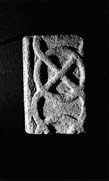Select a site alphabetically from the choices shown in the box below. Alternatively, browse sculptural examples using the Forward/Back buttons.
Chapters for this volume, along with copies of original in-text images, are available here.
Object type: Fragment of cross-shaft
Measurements: L. 49 cm (19.3 in) W. 31 cm (12.2 in) D. 17 cm (6.7 in)
Stone type: [Barnack Rag type, Upper Lincolnshire Limestone, Inferior Oolite Group]
Plate numbers in printed volume: Ill. 287
Corpus volume reference: Vol 5 p. 225
(There may be more views or larger images available for this item. Click on the thumbnail image to view.)
This is a small fragment from a large standing shaft. The fragment survives because the stone was recut for reuse as a voussoir, but as a result, only one original cut face remains (on the extrados). The surviving original face retains part of one original edge, where the angle was marked by a compound moulding, which is now only partly complete. Within this border the face of the shaft is decorated with interlace in low relief. The surviving interlace forms part of a well spaced run of two-strand plait incorporating at least one free ring.
Because of the great extent of recutting, it is unclear what type of shaft this fragment represents, although the size of the surviving interlace pattern must suggest that the shaft itself was of some considerable size. There are no very close parallels locally for shafts of this size and stone type decorated with such sparse interlace, but the presence of a free ring in the interlace pattern probably suggests a date in the later tenth or eleventh century. Furthermore the stone type (from Barnack/Clipsham) must associate this shaft with the South Kesteven shaft group, including Colsterworth 1 etc. (Chapter V and Table 2). It is not closely paralleled within this group, however, and has both a different character of panel border and is of atypical dimensions; nevertheless it is likely to be a product of the same quarries at approximately the same date, and deserves to be considered alongside them.



